The Art of Painting Easter Eggs Came From What Eastern European Country

A mix of modern, diasporan and traditional Ukrainian pysanky
A pysanka (Ukrainian: писанка, plural: pysanky) is a Ukrainian Easter egg, decorated with traditional folk designs using a wax-resist method. The word pysanka comes from the verb pysaty, "to write" or "to inscribe," as the designs are written (inscribed) with beeswax, not painted.
Many other Fundamental and Eastern European indigenous groups decorate eggs using wax resist for Easter. These include the Belarusians (пісанка, pisanka), Bulgarians (писано яйце, pisano yaytse), Carpatho-Rusyns (писанкы, pysankŷ), Croats (pisanica), Czechs (kraslice), Hungarians (hímestojás), Lithuanians (margutis), Poles (pisanka), Romanians (ouă vopsite, încondeiate or împistrite), Serbs (pisanica), Slovaks (kraslica), Slovenes (pirhi, pisanice, or remenke) and Sorbs (jejka pisać).
Types of decorated Ukrainian eggs [edit]
Pysanka is often taken to mean any type of busy egg, but it specifically refers to an egg created by the written-wax batik method and utilizing traditional folk motifs and designs. Several other types of decorated eggs are seen in Ukrainian tradition, and these vary throughout the regions of Ukraine.
- Krashanky — from krasyty (красити), "to decorate" — are boiled eggs dyed a single color (with vegetable dyes, traditionally onion skin), and are blest and eaten at Easter.
- Pysanky — from pysaty (писати), "to write" — are raw eggs created with the wax-resist method (Resist dyeing). The designs are "written" in hot wax with a pinhead or a special stylus chosen a pysachok (писачок) or a kistka (кістка) which has a modest funnel attached to hold a minor corporeality of liquid wax. The word that is used to depict the egg actually comes from the Ukrainian verb pysaty, which means "to write". Wooden eggs and beaded eggs are often referred to as "pysanky" because they mimic the decorative style of pysanky in a different medium.
- Krapanky — from krapka (крапка), "a dot" — are raw eggs busy using the wax-resist method, merely with only dots as ornamentation (no symbols or other drawings). They are traditionally created by dripping molten wax from a beeswax candle onto an egg. They can be considered the simplest version of a pysanka, or a "proto-pysanka".
- Driapanky — from driapaty (дряпати), "to scratch"– are created past scratching the surface of a dyed egg to reveal the white shell below.
- Maliovanky – from maliuvaty (малювати), "to pigment"– are created past painting a design with a castor using oil or water colour paints. It is sometimes used to refer to coloring (e.g. with a marker) on an egg.
- Nakleianky — from kleity (клеїти), "to glue on" — are created past glueing objects to the surface of an egg.
- Travlenky — from travlennia (травлення), "etching" – are created past waxing eggs and then etching away the unwaxed areas.
- Biserky — from biser (бісер), "beads" — are created by coating an egg with beeswax, and then embedding chaplet into the wax to create geometric designs.
- Lystovky — from lystia (листя), "leaves" — are created by dyeing an egg to which small leaves accept been attached.
All but the krashanky and lystovky are usually meant to exist decorative (as opposed to edible), and the egg yolk and white are either immune to dry upward over time or (in modern times) removed by blowing them out through a small hole in the egg.
In contempo years, new forms of egg ornamentation have been brought from abroad and become popularized in Ukraine. These include:
- Rizblenky — from rizbyty (різьбити), "to cutting, to carve" — are created by drilling the surface of an egg to create cut out areas.
- Linyvky — from linyvyi (лінивий), "lazy" — a joking term to describe eggs decorated using stickers or shrink-wrap sleeves.
History [edit]

According to many scholars, the fine art of wax-resist (batik) egg decoration in Slavic cultures probably dates back to the pre-Christian era. They base this on the widespread nature of the practice, and pre-Christian nature of the symbols used.[1] No ancient examples of intact pysanky exist, every bit the eggshells of domesticated fowl are frail, but fragments of colored shells with wax-resist ornamentation on them were unearthed during the archaeological excavations in Ostrówek, Poland (near the metropolis of Opole), where remnants of a Slavic settlement from the early on Piast Era were found.[2]
Every bit in many ancient cultures, Ukrainians worshipped a sun god, Dazhboh. The dominicus was important – it warmed the earth and thus was a source of all life. Eggs decorated with nature symbols became an integral part of jump rituals, serving every bit benevolent talismans.
In pre-Christian times, Dazhboh was 1 of the major deities in the Slavic pantheon; birds were the sun god'due south chosen creations, for they were the simply ones who could get near him. Humans could non catch the birds, but they did manage to obtain the eggs the birds laid. Thus, the eggs were magical objects, a source of life. The egg was likewise honored during rite-of-Leap festivals––it represented the rebirth of the world. The long, hard winter was over; the globe outburst forth and was reborn only as the egg miraculously burst forth with life. The egg therefore, was believed to take special powers.[three]
With the appearance of Christianity, via a procedure of religious syncretism, the symbolism of the egg was changed to represent, not nature'southward rebirth, but the rebirth of man. Christians embraced the egg symbol and likened it to the tomb from which Christ rose.[iv] With the acceptance of Christianity in 988, the busy pysanka, in fourth dimension, was adapted to play an of import role in Ukrainian rituals of the new religion.[5] Many symbols of the old sun worship survived and were adapted to correspond Easter and Christ's Resurrection.[v]
In mod times, the fine art of the pysanka was carried abroad past Ukrainian emigrants to N and South America, where the custom took hold, and concurrently banned as a religious practice in Ukraine by the Soviet regime, where it was almost forgotten.[six] Museum collections were destroyed both by war and by Soviet cadres.[half dozen] Since Ukrainian Independence in 1991, at that place has been a rebirth of this folk art in its homeland and a renewal of interest in the preservation of traditional designs and inquiry into its symbolism and history.
Archaeology [edit]
No actual pysanky have been plant from Ukraine's prehistoric periods, as eggshells do non preserve well. Cultic ceramic eggs take been discovered in excavations nigh the hamlet of Luka Vrublivets'ka, during excavations of a Trypillian site (fifth to tertiary millennium BC). These eggs were ornamented and in the grade of торохкальці (torokhkal'tsi; rattles containing a small stone with which to scare evil spirits abroad).[7]
Similarly, no actual pysanky from the Kyivan Rus' period exist, merely stone, clay and bone versions be and have been excavated in many sites throughout Ukraine. Most common are ceramic eggs decorated with a horsetail establish (сосонка sosonka) pattern in yellow and brilliant green against a dark groundwork. More than 70 such eggs have been excavated throughout Ukraine, many of them from graves of children and adults. They are thought to exist representations of existent decorated eggs.
These ceramic eggs were common in Kyivan Rus' and had a characteristic style. They were slightly smaller than life size (2.v past four cm, or 1 by one.6 inches) and were created from reddish pink clays past the spiral method. The majolica glazed eggs had a brownish, dark-green or yellow background and showed interwoven yellow and green stripes. The eggs were made in big cities like Kyiv and Chernihiv, which had workshops that produced clay tile and bricks; these tiles (and pysanky) were non but used locally only were exported to Poland and to several Scandinavian and Baltic countries.[8]
The oldest "real" pysanka was excavated in Lviv in 2013[9] and was constitute in a rainwater collection arrangement that dates to the 15th or 16th century. The pysanka was written on a goose egg, which was discovered largely intact, and the design is that of a wave pattern. The second oldest known pysanka was excavated in Baturyn in 2008 and dates to the end of the 17th century. Baturyn was Hetman Mazepa's upper-case letter, and it was razed in 1708 by the armies of Peter I. A complete (but crushed) pysanka was discovered, a chicken egg shell with geometric designs against a blue-gray background.[10]
[edit]
The Hutsuls—a group of Rusyns who live in the Carpathian Mountains around western Ukraine—believe that the fate of the earth depends upon the pysanka. As long equally the egg writing custom continues, the world will exist. If, for any reason, this custom is abandoned, evil—in the shape of a horrible serpent who is forever chained to a cliff—volition overrun the world. Each yr the serpent sends out his minions to see how many pysanky have been written. If the number is low the serpent's chains are loosened and he is gratuitous to wander the globe causing havoc and destruction. If, on the other hand, the number of pysanky has increased, the chains are tightened and good triumphs over evil for yet another year.[xi]
Newer legends blended sociology and Christian beliefs and firmly attached the egg to the Easter celebration. One legend concerns the Virgin Mary. It tells of the time Mary gave eggs to the soldiers at the cross. She entreated them to be less cruel to her son and she wept. The tears of Mary fell upon the eggs, spotting them with dots of vivid color.
Some other legend tells of when Mary Magdalene went to the sepulchre to anoint the body of Jesus. She had with her a basket of eggs to serve as a repast. When she arrived at the sepulchre and uncovered the eggs, the pure white shells had miraculously taken on a rainbow of colors.
A common legend tells of Simon the peddler, who helped Jesus bear his cross on the way to Calvary. He had left his goods at the side of the route, and, when he returned, the eggs had all turned into intricately busy pysanky.
Superstitions and folk beliefs [edit]
Many superstitions were fastened to pysanky. Pysanky were thought to protect households from evil spirits, ending, lightning and fires. Pysanky with screw motifs were the most powerful, equally the demons and other unholy creatures would be trapped within the spirals forever. A blessed pysanka could be used to find demons hidden in the nighttime corners of your business firm.
Pysanky held powerful magic, and had to exist disposed of properly, lest a witch get a hold of i. She could use the shell to get together dew, and utilize the gathered dew to dry upward a cow's milk. The witch could too use bits of the eggshell to poke people and sicken them. The eggshell had to be basis up very finely (and fed to chickens to make them good egg layers) or broken into pieces and tossed into a running stream.
The textile used to dry out pysanky was powerful, too, and could exist used to cure skin diseases. And information technology was considered very bad luck to trample on a pysanka—God would punish anyone who did with a diversity of illnesses.[12]
At that place were superstitions regarding the colors and designs on the pysanky. One erstwhile Ukrainian myth centered on the wisdom of giving older people gifts of pysanky with darker colors and/or rich designs, for their life has already been filled. Similarly, it is appropriate to requite young people pysanky with white as the predominant color because their life is still a bare folio. Girls would ofttimes requite pysanky to young men they fancied, and include eye motifs. It was said, though, that a girl should never give her boyfriend a pysanky that has no design on the top and bottom of the egg, equally this might signify that the young man would before long lose his hair.
Writing pysanky [edit]

An unfinished pysanka set for the blackness bathroom of dye. It bears the Ukrainian Easter greeting: "Christ is risen!"
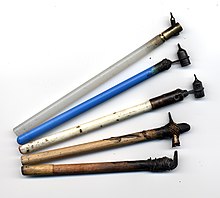
A variety of styluses, from traditional to mod
Each region, each village, and almost every family unit had its ain special ritual, its own symbols, meanings and secret formulas for dyeing eggs. These customs were preserved faithfully and passed downwards from mother to daughter through generations. The custom of decorating pysanky was observed with greatest care, and a pysanka, after receiving the Easter blessing, was held to take cracking powers as a talisman.
Pysanky were traditionally made during the last week of Lent, Holy Week in the Orthodox and Greek (Uniate) Cosmic calendars. (Both faiths are represented in Ukraine, and both however gloat Easter by the Julian calendar.) They were made by the women of the family. During the middle of the Lenten flavor, women began putting bated eggs, those that were almost perfectly shaped and smooth, and ideally, the first laid eggs of young hens. There had to be a rooster, as only fertilized eggs could be used. (If non-fertile eggs were used, at that place would exist no fertility in the abode.)
The dyes were prepared from dried plants, roots, bark, berries and insects (cochineal). Yellow was obtained from the flowers of the woadwaxen, and gold from onion skins. Red could be extracted from logwood or cochineal, and dark green and violet from the husks of sunflower seeds and the berries and bark of the elderberry bush. Black dye was fabricated from walnut husks. The dyes were prepared in hush-hush, using recipes handed down from mother to daughter. Sometimes chemical dyes (of unusual or difficult colors) were purchased from peddlers along with alum, a mordant that helped the natural dyes adhere better to eggshells.
A stylus, known as a pysachok, pysak, pysal'tse, or kystka (kistka), depending on region, was prepared. A piece of thin contumely was wrapped around a needle, forming a hollow cone. This was attached to a small stick (willow was preferred) with wire or horsehair. In the Lemko regions, a simple pin or nail inserted onto the finish of a stick was used instead (driblet-pull technique).
The pysanky were made at dark, when the children were comatose. The women in the family gathered together, said the appropriate prayers, and went to work. Information technology was done in secret—the patterns and color combinations were handed down from mother to girl and carefully guarded.
Pysanky were made using a wax resist (batik) method. Beeswax was heated in a small-scale bowl on the large family stove (піч), and the styluses were dipped into it. The molten wax was practical to the white egg with a writing movement; whatever chip of shell covered with wax would be sealed, and remain white. Then the egg was dyed yellow, and more wax applied, and then orange, cerise, imperial, black. (The dye sequence was always low-cal to night). Bits of crush covered with wax remained that colour. After the terminal color, usually red, brown or black, the wax was removed by heating the egg in the stove and gently wiping off the melted wax, or by briefly dipping the egg into boiling water.[13]
Boiled eggs were non used, as pysanky were generally written on raw or, less commonly, baked eggs (pecharky). Boiled eggs were dyed red for Easter, using an onion peel dye, and called "krashanky". The number of colors on an egg was usually limited, equally natural dyes had very long dyeing times, sometimes hours. Pysanky would exist written—and dyed—in batches.
Alternatively, in ethnic Lemko and Boiko areas, equally well as Nadsiannia, the drop pull method was as well utilized. A pinhead was dipped into molten wax and and so practical to the beat of the egg. Uncomplicated drops were made, or there was an additional pulling motion, which would create teardrop or comma shapes. These drops were used to create patterns and designs. Dyeing and wax removal proceeded every bit with traditional pysanky.
Pysanky keep to be made in mod times; while many traditional aspects have been preserved, new technologies are in testify. Aniline dyes have largely replaced natural dyes. Styluses are now fabricated with modern materials. Traditional styluses are still made from brass and wood, but those made with more than modern plastic handles are gaining in popularity. An electrical version of the stylus has been commercially bachelor since the 1970s, with the cone becoming a metal reservoir which keeps the melted beeswax at a constant temperature and holds a much larger amount than a traditional stylus. These newer styluses (whether electric or non) also sport machined heads, with sizes or the opening ranging from actress-actress-fine to extra-heavy.
Sharing pysanky [edit]

Pysanky are typically made to be given to family members and respected outsiders. To give a pysanka is to give a symbolic gift of life, which is why the egg must remain whole. Furthermore, the design, a combination of the motifs and colors on a traditional folk pysanka, has a deep, symbolic meaning. Traditionally, a pysanka given with its symbolic meaning in mind, be it wishes of protection, fecundity, or love. Typically, pysanky were displayed prominently in a public room of the house.
In a large family, by Holy Thursday, 60 or more than eggs would have been completed past the women of the house. (The more daughters a family had, the more pysanky would be produced.) The eggs would then be taken to the church on Easter Sunday to be blessed, after which they were given abroad. Here is a fractional list of how the pysanky would exist used:
- I or two would exist given to the priest.
- Three or iv were taken to the cemetery and placed on graves of the family.
- X or twenty were given to children or godchildren.
- 10 or twelve were exchanged past the single girls with the eligible men in the community.
- Several were saved to place in the coffin of loved ones who might die during the yr.
- Several were saved to go on in the abode for protection from fire, lightning and storms.
- Two or three were placed in the mangers of cows and horses to ensure safe calving and colting and a good milk supply for the immature.
- At to the lowest degree i egg was placed beneath the bee hive to ensure adept production of dearest.
- One was saved for each grazing animal to exist taken out to the fields with the shepherds in the bound.
- Several pysanky were placed in the nests of hens to encourage the laying of eggs.
Anybody from the youngest to the oldest received a pysanka for Easter. Young people were given pysanky with vivid designs; dark pysanky were given to older people.
A bowl full of pysanky was invariably kept in every home. It served not only as a colorful brandish, but likewise as protection from all dangers. Some of the eggs were emptied, and a bird's head made of wax or dough and wings and tail-feathers of folded newspaper were attached. These "doves" were suspended before icons in commemoration of the nascence of Christ, when a dove came down from heaven and soared over the child Jesus.
Traditional symbolism in pysanky [edit]

A basket total of Hutsul pysanky
A bang-up variety of ornamental motifs are found on pysanky. Because of the egg's fragility, few ancient examples of pysanky have survived. However, like design motifs occur in pottery, woodwork, metalwork, Ukrainian embroidery and other folk arts,[14] many of which have survived.
The symbols which decorated pysanky underwent a process of adaptation over time. In pre-Christian times these symbols imbued an egg with magical powers to ward off evil spirits, banish winter, guarantee a adept harvest and bring a person good luck. After 988, when Christianity became the country religion of Ukraine, the interpretation of many of the symbols began to change, and the pagan motifs were reinterpreted in a Christian light.
Since the mid-19th century, pysanky take been created more for decorative reasons than for the purposes of magic, particularly among the Diaspora, equally belief in virtually such rituals and practices has fallen past the wayside in a more than modern, scientific era. Additionally, the Ukrainian diaspora has reinterpreted meanings and created their ain new symbols and interpretations of older ones.[15]
The names and meaning of various symbols and blueprint elements vary from region to region, and even from village to village. Similar symbols tin accept totally dissimilar interpretations in different places. In that location are several m dissimilar motifs in Ukrainian folk designs. They can be grouped into several families. Proceed in listen that these talismanic meanings applied to traditional folk pysanky with traditional designs, not to modernistic original creations.
Geometric [edit]

The most pop pysanka designs are geometric figures. The egg itself is most often divided by straight lines into squares, triangles and other shapes. These shapes are then filled with other forms and designs. These are likewise amongst the virtually ancient symbols, with the решето (resheto, sieve) motif dating dorsum to Paleolithic times. Other aboriginal geometric symbols are agricultural in nature: triangles, which symbolized clouds or rain; quadrilaterals, particularly those with a resheto design in them, symbolized a ploughed field; dots stood for seeds.
Geometric symbols used quite usually on pysanky today. The triangle is said to symbolize the Holy Trinity; in ancient times it symbolized other trinities: the elements of air, burn down and water, the family unit (man, woman and child) or the cycle of life (nascency, life, and death). Diamonds, a type of quadrilateral, are sometimes said to symbolize noesis. Curls/spirals are ancient symbols of the Zmiya/Serpent, and are said to have a meaning of defense force or protection.
The spiral is said to exist protective against the "нечиста сила"; an evil spirit which happens to enter a business firm will be drawn into the spiral and trapped at that place. Dots, which can represent seeds, stars or cuckoo birds' eggs (a symbol of spring), are popularly said to be the tears of the blessed Virgin. Hearts are besides sometimes seen, and, as in other cultures, they correspond dear.
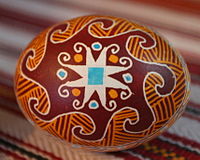
A meander motif on a traditional pysanka
An adaptation of the geometric design is not a symbol per se but a division of the egg called "forty triangles" (actually 48) or "Sorokoklyn (forty wedges)." Its ancient meaning is not known, only is oftentimes said to represent the twoscore days of lent, the twoscore martyrs, the forty days that Christ spent in the desert, or the forty life tasks of married couples.
Eternity bands [edit]
Eternity bands or meanders are composed of waves, lines or ribbons; such a line is called a "bezkonechnyk." A line without cease is said to represent immortality. Waves, all the same, are a water symbol, and thus a symbol of the Zmiya/Serpent, the ancient water god. Waves are therefore considered an agricultural symbol, because information technology is rain that ensures good crops.
Berehynia [edit]
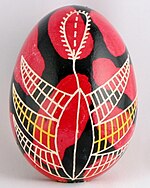
A traditional pysanka with a berehynia motif
The goddess motif is an ancient one, and most normally institute in pysanky from Bukovyna, Polissia or Podillia. The berehynia was believed to be the source of life and decease. On the one hand, she is a life giving mother, the creator of sky and all living things, and the mistress of heavenly water (pelting), upon which the world relies for fertility and fruitfulness. On the other manus, she was the merciless controller of destinies.
The goddess is sometimes depicted with artillery upraised, and the arms vary in number merely are always in pairs: two, 4 or 6. This is similar to the appearance of the Christian Oranta. Pysanky with this motif were called "bohyn'ky" (богиньки, footling goddesses) or "zhuchky" (жучки, beetles), the latter because they are similar in advent to the Cyrillic letter Ж (zh). Sometimes the berehynia has become abstracted, and is represented by a plant—vazon—the tree of life. Her artillery become the branches and flowers, and she is firmly rooted in a flowerpot.
The most common depiction of the not bad goddess is a composition containing "kucheri" (curls). The berehynia may exist seen perched on a curl, or a curl may be given wings; the symbol may exist doubled, end-to-finish. There is usually a crown on the berehynia's head. These compositions are given the folk names of "queen," "princess," "rooster," "scythe," "drake," or simply "wings."
Christian symbols [edit]

A traditional pysanka with a church building motif
The only true traditional Christian symbol, and not 1 adjusted from an before pagan[ commendation needed ] one, is the church. Stylized churches are often found on pysanky from Hutsul regions (including parts of Bukovyna). Church parts are usually in threes: three stories/roofs, three towers, 3 openings (windows, doors). Sometimes simply the bell tower (dzvinytsia) is depicted.
Crosses are adequately mutual, although most of those found on traditional pysanky are non Ukrainian (Byzantine) crosses. The crosses most commonly depicted are of the simple "Greek" cross blazon, with artillery of equal lengths. This type of cantankerous predates Christianity, and is a dominicus symbol (an abstracted representation of the solar bird); it is sometimes combined with the star (ruzha) motif. The "cross crosslet" type of cantankerous, one in which the ends of each arm are crossed, is frequently seen, particularly on Hutsul and Bukovynian pysanky.
Other adapted religious symbols include a triangle with a circle in the center, denoting the middle of God, and i known as the "mitt of god."
In the 20th and 21st centuries, the commercially produced folk pysanky of the Carpathians, particularly Kosmach, have begun displaying more Christian symbols. The lower arm of the cross in older designs is oft lengthened to appear more than Christian, even if it throws off the symmetry of the design. Crucifixes are sometimes seen. Pysanky are being written with depictions of Easter baskets on them, including a paska and candle. White doves, symbols of the Holy Spirit, are likewise more frequently seen; doves are ordinarily depicted in flight, while other wild birds are traditionally shown perched.
Phytomorphic (plant) motifs [edit]
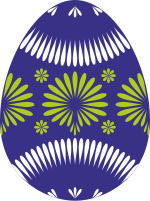
The near common motifs institute on pysanky are those associated with plants and their parts (flowers and fruit). Women who wrote pysanky drew their inspiration from the world of nature, depicting flowers, copse, fruits, leaves and whole plants in a highly stylized (not realistic) manner. Such ornaments symbolized the rebirth of nature afterwards winter, and pysanky were written with plant motifs to guarantee a good harvest. A near popular floral blueprint is a plant in a vase of continuing on its own, which symbolized the tree of life and was a highly bathetic version of the berehynia (keen goddess).
Pysanky created by the mountain people of the Hutsul region of Ukraine often showed a stylized fir tree branch, a symbol of youth and eternal life. Trees, in full general, symbolized strength, renewal, creation, growth; equally with animal motifs, the parts (leaves, branches) had the aforementioned symbolic meaning as the whole. The oak tree was a sacred to the ancient god Perun, the most powerful of the infidel Slavic pantheon, and thus oak leaves symbolized strength.
Pussy willow branches are sometimes depicted on pysanky; in Ukraine, the pussy willow replaces the palm foliage on Palm Sunday. This is not a common motif, though, and may be a more than recent improver.
2 very popular constitute motifs on modern diasporan pysanky are poppies and wheat; these motifs are never seen on traditional pysanky, and are purely a mod invention.
Flowers [edit]
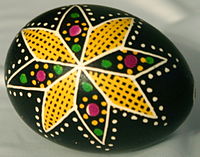
A Ukrainian pysanka with a ruzha (eight pointed star) motif
Flowers are a common pysanka motif. They can exist divided into two types: specific botanical types, and non-specific.
Specific botanical types include sunflowers, daisies, violets, carnations, periwinkle and lily-of the-valley. These flowers are represented with identifying features that make them recognizable. Carnations volition have a serrated edge to the petals, the flowers of the lily of the valley will be arrayed along a stem, periwinkle will have 3 or iv leaves (periwinkle is represented by its leaves, not its flowers, on pysanky).
At that place are too flower motifs called orchids and tulips, simply these are not botanical names. They are actually the names given to fantastical flowers, as neither of these flowers was unremarkably found in Ukraine until modern times. The names reflected the exoticism of the designs.
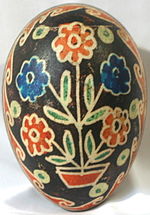
Traditional Ukrainian pysanka from Bukovyna region, with a vazon motif
Non-specific flowers are much more common, and consist of the ruzha and others. The ruzha (or rozha) is named afterwards the mallow blossom, although it does not resemble one, and is another proper noun given to the eight-pointed star motif. A ruzha tin can be total, empty, chemical compound, divided or fifty-fifty crooked. It is a sun sign. Other not-specific types oft have hyphenated names: potato-flower, strawberry-flower, etc. They are usually simple arrangements of petals, 6 or more, and deport piddling resemblance to the plant they are named for.
Vazon/Tree of Life [edit]
The "tree of life" motif is widely used in traditional pysanky designs. It tin be represented in many ways. Sometimes it appears as two deer on either side of a pine tree. More often it manifests every bit a blossom pot ("vazon"), filled with leaves and flowers. The pot itself is commonly a rectangle, triangle or a rhomboid (symbolic of the earth), and is covered with dots (seeds) and dashes (water). Many branches grow out of it, in a symmetric way, with leaves and flowers. This plant is a berehynia (goddess) symbol, with the branches representing the many arms of the mother goddess.
Fruit [edit]
Fruit is not a common motif on pysanky, merely is sometimes represented. Apples, plums and cherries are depicted on traditional pysanky. Currants and viburnum (kalyna) berries are sometimes seen, also. These motifs are probably related to fecundity. Grapes are seen more frequently, as they take been transformed from an agricultural motif to a religious 1, representing the Holy Communion.
Scevomorphic motifs [edit]

A traditional Ukrainian pysanka with rake motifs
Skeuomorphic designs are the second-largest group of designs, and are representations of man-fabricated agricultural objects. These symbols are very common, as Ukraine was a highly agronomical club, and drew many of its positive images from field and farm. Some of these symbols are related to agriculture; others have older meanings, just were renamed in more recent times based on their appearance.
Common symbols include the ladder, symbolizing prayers going up to sky, and the sieve (resheto), standing for a plowed field, or perhaps the separation of skillful and evil. Rakes and combs are often depicted; both are meant to invoke a good harvest. Both are pelting symbols. The body of the rake (sometimes depicted as a triangle) is the cloud, and the teeth symbolize rain drops. (Notation: these combs are not pilus combs, but agronomical implements, see Harrow (tool).)
Windmills, a variation on the cleaved cross (swastika) motif, are sun symbols. The motility of the cross echoes the movement of the sun across the sky.
Zoomorphic (animal) motifs [edit]

Although animal motifs are not as pop as institute motifs, they are still institute on pysanky, especially those of the people of the Carpathian Mountains. Animal depicted on pysanky include both wild fauna (deer, birds, fish) and domesticated ones (rams, horses, poultry). Every bit with plants, animals were depicted in the abstract, highly stylized, and not with realistic particular.
Horses were popular ornaments considering they symbolized force and endurance, likewise every bit wealth and prosperity. They likewise had a second meaning as a dominicus symbol: in some versions of pagan mythology, the dominicus was drawn beyond the heaven past the steeds of Dazhboh, the sunday god. Similarly, deer designs were fairly common as they were intended to bring prosperity and long life; in other versions of the myth, it was the stag who carried the sunday beyond the sky on his antlers. Rams are symbols of leadership, strength, dignity, and perseverance.
Onetime women simply drew parts of animals; these symbols were probably a sort of shorthand, endowed with all the attributes of the fauna represented. Ducks' necks, goose feet, rabbits' ears, rams' horns, wolves' teeth, bear claws, and bulls' eyes can all be found on pysanky. One cannot exist sure, however, if these symbols were actually meant to represent animals, or were renamed centuries afterwards because of their appearance.
Birds [edit]
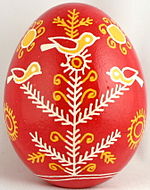
A traditional Ukrainian pysanka with bird motifs
Birds were considered the harbingers of bound, thus they were a commonplace pysanka motif. Birds of all kinds are the messengers of the sunday and heaven. Birds are always shown perched, at rest, never flying (except for swallows and, in more recent times, white doves carrying letters). Roosters are symbols of masculinity, or the coming of dawn, and hens represent fertility.
Birds were almost always shown in full profile, stylized, but with feature features of the species. Partial representations of some birds––generally domestic fowl––are oft seen on pysanky. Bird parts (optics, feet, beaks, combs, feathers) are said bear the same meaning as the entire bird. Thus hen's feet stand for fertility and the rooster's comb signifies masculinity.
Insects [edit]
Insects are only rarely depicted on pysanky. Highly stylized spiders (and occasionally their webs) are the most common on folk pysanky, and symbolize perseverance. Beetles are sometimes seen, only rarely look anything like a protrude. What they do resemble, somewhat, is the letter Ж, every bit in their Ukrainian proper noun "жучок." Other insects are sometimes seen on modernistic, diasporan pysanky, most commonly butterflies and bees, but seem to exist a mod innovation. In Onyshchuk's "Symbolism of the Ukrainian Pysanka" she depicts pysanky with a butterfly motif, just the original design, recorded by Kulzhynsky in 1899, was labeled as being swallows' tails.
Fish [edit]

A traditional Ukrainian pysanka with spirals
The fish, originally a symbol of wellness, somewhen came to symbolize Jesus Christ, the "fisher of men." In old Ukrainian fairy tales, the fish frequently helped the hero to win his fight with evil. In the Greek alphabet "fish" (ichthys) is an acrostic of "Jesus Christ, Son of God, Savior," and it became a underground symbol used past the early Christians. The fish represents abundance, besides as Christian interpretations of baptism, sacrifice, the powers of regeneration, and Christ himself.
Ophidian [edit]
Another ancient symbol is that of the змія or serpent, the ancient god of water and earth. The serpent could be depicted in several ways: as an "S" or sigma, every bit a curl or screw, or every bit a wave. When depicted equally a sigma, the zmiya often wears a crown. Depictions of the serpent tin be found on Neolithic Trypillian pottery. The serpent symbol on a pysanka is said to bring protection from ending. Spirals were peculiarly strong talismans, as an evil spirit, upon entering the house, would exist drawn into the spiral and trapped at that place.
Cosmomorphic motifs [edit]

Traditional pysanka with a swastika (svarha) motif
Among the oldest and near of import symbols of pysanky is the lord's day, and the simplest rendering of the sun is a airtight circle with or without rays. Pysanky from all regions of Ukraine depict an eight-sided star, the most common delineation of the sun; this symbol is also called a "ruzha." Half-dozen- or vii-sided stars can also be seen, but much less normally.
The sun can likewise appear equally a flower or a трилист (three leafage). The swastika, called in Ukrainian a "svarha," is sometimes referred to equally a "broken cross" or "ducks' necks." It represented the sun in pagan times: the motility of the arms effectually the cross represented the movement of the sun across the sky. The Slavic pagans also believed that the sun did not rise on its own, just was carried beyond the sky by a stag (or, in some versions, a equus caballus). The deer and horses often found on Hutsul pysanky are solar symbols.
Pysanky with lord's day motifs were said to have been especially powerful, because they could protect their owner from sickness, bad luck and the evil centre. In Christian times the lord's day symbol is said to represent life, warmth, and the love and the Christian God.
Other cosmomorphic symbols are less commonly seen. The moon is sometimes depicted as a circle with a cantankerous within it; it is begged to shed its light at night to help the traveller, and to hunt away evil powers from the household. Stars are sometimes represented every bit dots.
Mod symbolism in pysanky [edit]

Modern easter eggs besides depict other symbols, memes and inscriptions. With the beginning of the full-scale Russian invasion in 2022, the images caused a patriotic significant. In that location are tridents, a rooster of Vasylkiv majolica, tractors (pulling armored vehicles), inscriptions "Oh in the meadow", "For the liberty of Ukraine", "I believe in Ukrainian Armed Forces", etc.[16] [17]
The trend for Ukrainian Pysanka has also spread to foreign designers who create such Pysankas with a rethinking of their symbolism.[18]
Color symbolism [edit]
Information technology is not merely motifs on pysanky which carried symbolic weight: colors as well had significance. Although the earliest pysanky were often simply two-toned, and many folk designs nonetheless are, some believed that the more colors at that place were on a decorated egg, the more magical power information technology held. A multi-colored egg could thus bring its owner better luck and a better fate.
The color palette of traditional pysanky was fairly limited, and based on natural dyes. Yellow, red/orange, greenish, brown and black were the predominant colors. With the advent of aniline dyes in the 1800s, small amounts of blue and purple were sometimes added. Information technology is of import to annotation that the meanings below are generalizations; different regions interpreted colors differently.[half-dozen]
- Red - is probably the oldest symbolic color, and has many meanings. It represents life-giving blood, and often appears on pysanky with nocturnal and heavenly symbols. It represents dearest and joy, and the promise of marriage. It is also associated with the dominicus.
- Black - is a specially sacred color, and is most unremarkably associated with the "other world," merely not in a negative sense.
- Yellow - symbolized the moon and stars and besides, agriculturally, the harvest.
- Blue - Represented blue skies or the air, and good health.
- White - Signified purity, nativity, light, rejoicing, virginity.
- Green - the color of new life in the spring. Green represents the resurrection of nature, and the riches of vegetation.
- Brownish - represents the world.
Some color combinations had specific meanings, too:
- Black and white - mourning, respect for the souls of the dead.
- Black and carmine - this combination was perceived as "harsh and frightful," and very disturbing. It is mutual in Podillya, where both serpent motifs and goddess motifs were written with this combination.
- Four or more colors - the family unit'southward happiness, prosperity, dear, health and achievements.
Equally with symbols, these talismanic meanings of colors applied to traditional pysanky with traditional designs, and not to modern decorative pysanky.
Come across also [edit]
| | Wikimedia Commons has media related to Pysanka. |
- Egg decorating in Slavic culture
- Pisanka
- Pysanka Museum
- Luba Perchyshyn
References [edit]
- ^ Kилимник, Степан. Український рік у народних звичаях в історичному освітленні, том. ІІІ, Весняний цикль. Winnipeg, Toronto: Ukrainian Research Institute of Volyn' pp. 189-191
- ^ "Opole: najstarsze polskie "pisanki" znaleziono na opolskim Ostrówku". onet.pl. 31 March 2013.
- ^ Manko, Vira. The Ukrainian Folk Pysanka L'viv, Ukraine: Svichado, 2005
- ^ Anne Jordan (five April 2000). Christianity. Nelson Thornes. ISBN9780748753208 . Retrieved 7 April 2012.
Easter eggs are used equally a Christian symbol to represent the empty tomb. The outside of the egg looks dead but inside there is new life, which is going to break out. The Easter egg is a reminder that Jesus will rise from His tomb and bring new life.
- ^ a b Біняшевський, Ераст. Українські Писанки (Ukrainian Pysanky) Київ: «Мистецтво», 1968
- ^ a b c Manko, Vira (2008). The Ukrainian Folk Pysanka (2d ed.). Fifty'viv, Ukraine: Svichado. ISBN978-9668744235. Archived from the original on 2015-05-19. Retrieved 2016-08-x .
- ^ Кириченко, М.А. Український Народний Декоративний Розпис Київ: «Знання-Прес», 2008
- ^ Tkachuk, Mary et al. Pysanka: Icon of the Universe Saskatoon: Ukrainian Museum, 1977
- ^ "Археологи у Львові виявили унікальну писанку, якій понад 500 років. Фото". galinfo.com.ua.
- ^ Потапчук Наталія. УКРІНФОРМ 23-07-2008
- ^ Воропай, Олекса. Звичаї Нашого Народу (Folk Community of Our People) Київ: «Оберіг», 1993.
- ^ Воропай, Олекса. Звичаї Нашого Народу (Folk Customs of Our People) Київ: «Оберіг», 1993
- ^ "Where Easter Eggs Rival The Rainbow." Pop Mechanics, Apr 1944, pp. 88-89.
- ^ Selivachov, Mykhailo. Folk Designs of Ukraine Doncaster, Commonwealth of australia: Bayda Books, 1995
- ^ Lesiv, Mariya . From Ritual Object To Art Form: The Ukrainian Easter Egg Pysanka In Its Canadian Context. Folklorica, Journal of the Slavic and East European Folklore Association. Vol 12 (2007)
- ^ "«Вірю в ЗСУ». У Вінниці запрошують створити писанки для наших військових - 20 хвилин". vn.20minut.ua (in Ukrainian). Retrieved 2022-04-25 .
- ^ Шевчук, Катерина (2022-04-25). "На аукціоні у Хмельницькому продали поштову марку". Суспільне | Новини (in Ukrainian). Retrieved 2022-04-25 .
- ^ "ВЕЛИКОДНІ ПОДАРУНКИ НАШИХ ПОБРАТИМІВ — Телеканал I-UA.tv". i-ua.tv (in Ukrainian). 2022-04-23. Retrieved 2022-04-25 .
External links [edit]
| | Look up pysanka in Wiktionary, the free dictionary. |
- Pysanka Museum
- Community and Traditions
- Pysanka Writing Videos
- Pysanka Ethnography
Source: https://en.wikipedia.org/wiki/Pysanka
0 Response to "The Art of Painting Easter Eggs Came From What Eastern European Country"
Post a Comment